|
|
|
Sort Order |
|
|
|
Items / Page
|
|
|
|
|
|
|
| Srl | Item |
| 1 |
ID:
085266
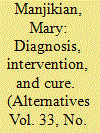

|
|
|
|
|
| Publication |
2008.
|
| Summary/Abstract |
Failed states discourse rests on an illness narrative. As the failing state battles against invasion by the terrorism "virus" the United State serves as physician, Diagnosing, trrating and sometime "curing" the patient.
|
|
|
|
|
|
|
|
|
|
|
|
|
|
|
|
| 2 |
ID:
103485
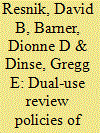

|
|
|
|
|
| Publication |
2011.
|
| Summary/Abstract |
To address biosecurity issues, government agencies, academic institutions, and professional societies have developed policies concerning the publication of "dual-use" biomedical research-that is, research that could be readily applied to cause significant harm to the public, the environment, or national security. We conducted an e-mail survey of life science journals to determine the percentage that have a dual-use policy. Of the 155 journals that responded to our survey (response rate 39%), only 7.7% stated that they had a written dual-use policy and only 5.8% said they had experience reviewing dual-use research in the past 5 years. Among the potential predictors we investigated, the one most highly associated with a journal having a written dual-use policy was membership in the Nature Publishing Group (positive association). When considered individually, both previous experience with reviewing dual-use research and the journal's impact factor appeared to be positively associated with having a written dual-use policy, but only the former remained significant after adjusting for publishing group. Although preventing the misuse of scientific research for terrorist or criminal purposes is an important concern, few biomedical journals have dual-use review policies. Journals that are likely to review research that raises potential dual-use concerns should consider developing dual-use policies.
|
|
|
|
|
|
|
|
|
|
|
|
|
|
|
|
| 3 |
ID:
125972
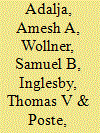

|
|
|
|
|
| Publication |
2012.
|
| Summary/Abstract |
Recent cases of counterfeit and contaminated medication have raised concerns about the integrity of the US supply chain of pharmaceuticals. Moreover, Shortage in oncology drug have highlighted a weak domestic production capacity for essential medication. The FDA and the Pew Charitable Trusts have published analyses of the problem as they relate to the US's regulatory system and healthcare industry. These issues also represent a potential national security threat.
|
|
|
|
|
|
|
|
|
|
|
|
|
|
|
|
| 4 |
ID:
095923
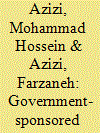

|
|
|
|
|
| Publication |
2010.
|
| Summary/Abstract |
The first Iranian to study medicine abroad was sent to Britain by the Iranian government in 1811, during the early decades of the Qajar period (1796-1925). The second student was sent to France in 1815, along with four other students. Another group of five students, including the third student of medicine, was sent to France in 1845. Forty-two others, including five medical students, were dispatched to France in 1858. Most members of the latter group were among the first graduates of Tehran Dar al-Fonun (House of Techniques) School. Then, in 1928, during Reza Shah Pahlavi's reign (1925-41), a special act was passed by the Iranian parliament (Majlis) according to which the Ministry of Education would send 100 students abroad annually for higher education at the government's expense. The practice was suspended in 1935 with the advent of the Second World War. Between 1928 and 1935, a total of 640 students, including 125 medical students, were sent abroad. The majority of the medical students (84 percent) were sent to France. Most of these medical graduates returned to Iran and in subsequent years played a significant role in further propagation of modern medical knowledge in the country. The paper presents a brief historical account of the conditions of public health and medical education between 1811 and 1935 as well as biographical sketches of some of the best-known or most influential medical figures among these graduates.
|
|
|
|
|
|
|
|
|
|
|
|
|
|
|
|
| 5 |
ID:
126092


|
|
|
|
|
| Publication |
2012.
|
| Summary/Abstract |
This article summarizes major points from a newly released guide published online by the Office of the Assistant Secretary for Preparedness and Response (ASPR). The article reviews basic principles about radiation and its measurement, short-term and long-term effects of radiation, and medical countermeasures as well as essential information about how to prepare for and respond to a nuclear detonation. A link is provided to the manual itself, which in turn is heavily referenced for readers who wish to have more
|
|
|
|
|
|
|
|
|
|
|
|
|
|
|
|
| 6 |
ID:
188259
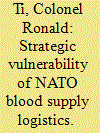

|
|
|
|
|
| Summary/Abstract |
If an event triggers Article V and NATO is drawn into defensive combat operations, there could well be more dead and wounded than the West has encountered before. Most casualties will result from combat trauma and require both surgery and blood transfusion to survive. Under NATO’s split “collective-individual” responsibility system, should national blood logistic systems be unable to deliver; and with NATO unable to exercise overall coordination, serious consequences for individual morale, the will to fight, and overall combat capability will occur, producing dire strategic outcomes. This article focusses on NATO blood supply logistics and highlights current deficiencies, using Estonian Defence Force blood supply logistics as its working example. The article’s principal argument is that blood supply logistics has “tactical-level” effects which have critical flow-on strategic effects on issues such as force preservation and morale. Blood supply logistics is a complex issue urgently requiring concerted NATO, multinational, and national attention.
|
|
|
|
|
|
|
|
|
|
|
|
|
|
|
|
|
|
|
|
|